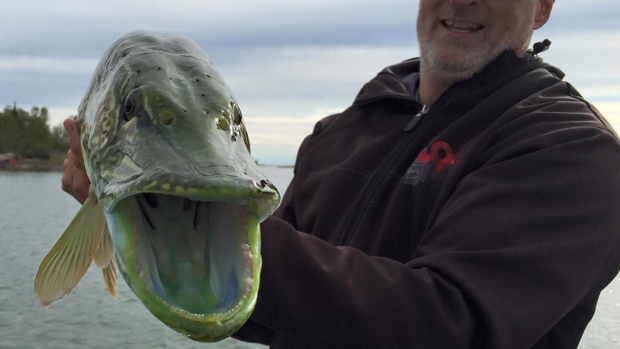‘This fish was totally, head to tail, like nothing we’d ever seen,’ said Randy Straker
Originally Published by CBC News, August 26, 2015
By Northwind
It’s not the Loch Ness monster, but a Yellowknife angler has ignited debate of his own after landing, and then releasing, a fluorescent green pike while fishing in Great Slave Lake.
“The whole top of the fish had a different green,” said Randy Straker. “If you look at the mouth, it looked like green lipstick. It was so bright.”
Straker was fishing with his friend Craig Thomas on Sunday in the lake’s North Arm when he made the catch.
After pulling the pike into the boat — Straker estimated it at 38 to 40 inches and 12 to 14 pounds — the two men snapped a few photos and released their catch. Afterward, though, they realized that they’d caught something quite unique.
“In hindsight, after looking at the pictures, we should have taken a whole lot more,” he said. “But we compared some pictures that we’d taken previously of a fish. And when you put it up against another pike, it’s way lighter. The fins were kind of a translucent green as opposed to the darker colours of a regular pike.
Avid fishermen, Thomas and Straker had worked their way around the lake for the past five years, and had “just started … exploring in that area,” said Straker.
The two were finishing up their day when Straker landed the fish. Pike, also known as jackfish, are common in Great Slave Lake, but when the catch passed by the boat, both men realized something was different.
“I was wearing polarized lenses, and I thought maybe that was causing some different coloration in the fish,” he said. “I was just about to pull my glasses off to take another look… and then my buddy made a comment about how strange the fish looked.
“Reeled it in a little tighter, and then just as it got close to the boat it kind of flared its gills and its mouth came wide open. And you could see right down its throat, and it was very fluorescent green.”
‘Like nothing we’d ever seen’
Asked if he’d seen anything like the pike before, Straker’s response was emphatic: “Nothing even close.
“We’ve seen kind of the albino look, where you might get a 50/50 split, where half the fish is lacking pigment, or we’ve seen some irregular spots, but this fish was totally, head to tail, like nothing we’d ever seen.”
Straker posted the photos of his catch on social media, igniting a debate about what could have caught the coloration. There are “lots of theories,” he said, but so far, nothing definitive.
“We thought maybe diet… maybe whatever it got into eating, but nothing concrete. The biologists that have given any feedback have suggested that they have no clue really what’s caused it.”
No biologists will be able to examine the fish itself: it’s now back in Great Slave, the deepest lake in North America, “to be caught another day.
“We hope to get out this weekend,” Straker said. “Maybe we can find some more of those.”
Photo courtesy of Craig Thomas







